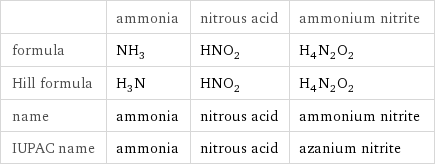Input interpretation

NH_3 ammonia + HNO_2 nitrous acid ⟶ H_4N_2O_2 ammonium nitrite
Balanced equation

Balance the chemical equation algebraically: NH_3 + HNO_2 ⟶ H_4N_2O_2 Add stoichiometric coefficients, c_i, to the reactants and products: c_1 NH_3 + c_2 HNO_2 ⟶ c_3 H_4N_2O_2 Set the number of atoms in the reactants equal to the number of atoms in the products for H, N and O: H: | 3 c_1 + c_2 = 4 c_3 N: | c_1 + c_2 = 2 c_3 O: | 2 c_2 = 2 c_3 Since the coefficients are relative quantities and underdetermined, choose a coefficient to set arbitrarily. To keep the coefficients small, the arbitrary value is ordinarily one. For instance, set c_1 = 1 and solve the system of equations for the remaining coefficients: c_1 = 1 c_2 = 1 c_3 = 1 Substitute the coefficients into the chemical reaction to obtain the balanced equation: Answer: | | NH_3 + HNO_2 ⟶ H_4N_2O_2
Structures

+ ⟶
Names

ammonia + nitrous acid ⟶ ammonium nitrite
Equilibrium constant
![Construct the equilibrium constant, K, expression for: NH_3 + HNO_2 ⟶ H_4N_2O_2 Plan: • Balance the chemical equation. • Determine the stoichiometric numbers. • Assemble the activity expression for each chemical species. • Use the activity expressions to build the equilibrium constant expression. Write the balanced chemical equation: NH_3 + HNO_2 ⟶ H_4N_2O_2 Assign stoichiometric numbers, ν_i, using the stoichiometric coefficients, c_i, from the balanced chemical equation in the following manner: ν_i = -c_i for reactants and ν_i = c_i for products: chemical species | c_i | ν_i NH_3 | 1 | -1 HNO_2 | 1 | -1 H_4N_2O_2 | 1 | 1 Assemble the activity expressions accounting for the state of matter and ν_i: chemical species | c_i | ν_i | activity expression NH_3 | 1 | -1 | ([NH3])^(-1) HNO_2 | 1 | -1 | ([HNO2])^(-1) H_4N_2O_2 | 1 | 1 | [H4N2O2] The equilibrium constant symbol in the concentration basis is: K_c Mulitply the activity expressions to arrive at the K_c expression: Answer: | | K_c = ([NH3])^(-1) ([HNO2])^(-1) [H4N2O2] = ([H4N2O2])/([NH3] [HNO2])](../image_source/229adec2945da3bd10551074e6e41526.png)
Construct the equilibrium constant, K, expression for: NH_3 + HNO_2 ⟶ H_4N_2O_2 Plan: • Balance the chemical equation. • Determine the stoichiometric numbers. • Assemble the activity expression for each chemical species. • Use the activity expressions to build the equilibrium constant expression. Write the balanced chemical equation: NH_3 + HNO_2 ⟶ H_4N_2O_2 Assign stoichiometric numbers, ν_i, using the stoichiometric coefficients, c_i, from the balanced chemical equation in the following manner: ν_i = -c_i for reactants and ν_i = c_i for products: chemical species | c_i | ν_i NH_3 | 1 | -1 HNO_2 | 1 | -1 H_4N_2O_2 | 1 | 1 Assemble the activity expressions accounting for the state of matter and ν_i: chemical species | c_i | ν_i | activity expression NH_3 | 1 | -1 | ([NH3])^(-1) HNO_2 | 1 | -1 | ([HNO2])^(-1) H_4N_2O_2 | 1 | 1 | [H4N2O2] The equilibrium constant symbol in the concentration basis is: K_c Mulitply the activity expressions to arrive at the K_c expression: Answer: | | K_c = ([NH3])^(-1) ([HNO2])^(-1) [H4N2O2] = ([H4N2O2])/([NH3] [HNO2])
Rate of reaction
![Construct the rate of reaction expression for: NH_3 + HNO_2 ⟶ H_4N_2O_2 Plan: • Balance the chemical equation. • Determine the stoichiometric numbers. • Assemble the rate term for each chemical species. • Write the rate of reaction expression. Write the balanced chemical equation: NH_3 + HNO_2 ⟶ H_4N_2O_2 Assign stoichiometric numbers, ν_i, using the stoichiometric coefficients, c_i, from the balanced chemical equation in the following manner: ν_i = -c_i for reactants and ν_i = c_i for products: chemical species | c_i | ν_i NH_3 | 1 | -1 HNO_2 | 1 | -1 H_4N_2O_2 | 1 | 1 The rate term for each chemical species, B_i, is 1/ν_i(Δ[B_i])/(Δt) where [B_i] is the amount concentration and t is time: chemical species | c_i | ν_i | rate term NH_3 | 1 | -1 | -(Δ[NH3])/(Δt) HNO_2 | 1 | -1 | -(Δ[HNO2])/(Δt) H_4N_2O_2 | 1 | 1 | (Δ[H4N2O2])/(Δt) (for infinitesimal rate of change, replace Δ with d) Set the rate terms equal to each other to arrive at the rate expression: Answer: | | rate = -(Δ[NH3])/(Δt) = -(Δ[HNO2])/(Δt) = (Δ[H4N2O2])/(Δt) (assuming constant volume and no accumulation of intermediates or side products)](../image_source/ea0caba275b9bed5e782f95a7cdc044c.png)
Construct the rate of reaction expression for: NH_3 + HNO_2 ⟶ H_4N_2O_2 Plan: • Balance the chemical equation. • Determine the stoichiometric numbers. • Assemble the rate term for each chemical species. • Write the rate of reaction expression. Write the balanced chemical equation: NH_3 + HNO_2 ⟶ H_4N_2O_2 Assign stoichiometric numbers, ν_i, using the stoichiometric coefficients, c_i, from the balanced chemical equation in the following manner: ν_i = -c_i for reactants and ν_i = c_i for products: chemical species | c_i | ν_i NH_3 | 1 | -1 HNO_2 | 1 | -1 H_4N_2O_2 | 1 | 1 The rate term for each chemical species, B_i, is 1/ν_i(Δ[B_i])/(Δt) where [B_i] is the amount concentration and t is time: chemical species | c_i | ν_i | rate term NH_3 | 1 | -1 | -(Δ[NH3])/(Δt) HNO_2 | 1 | -1 | -(Δ[HNO2])/(Δt) H_4N_2O_2 | 1 | 1 | (Δ[H4N2O2])/(Δt) (for infinitesimal rate of change, replace Δ with d) Set the rate terms equal to each other to arrive at the rate expression: Answer: | | rate = -(Δ[NH3])/(Δt) = -(Δ[HNO2])/(Δt) = (Δ[H4N2O2])/(Δt) (assuming constant volume and no accumulation of intermediates or side products)
Chemical names and formulas

| ammonia | nitrous acid | ammonium nitrite formula | NH_3 | HNO_2 | H_4N_2O_2 Hill formula | H_3N | HNO_2 | H_4N_2O_2 name | ammonia | nitrous acid | ammonium nitrite IUPAC name | ammonia | nitrous acid | azanium nitrite
Substance properties

| ammonia | nitrous acid | ammonium nitrite molar mass | 17.031 g/mol | 47.013 g/mol | 64.04 g/mol phase | gas (at STP) | | melting point | -77.73 °C | | boiling point | -33.33 °C | | density | 6.96×10^-4 g/cm^3 (at 25 °C) | | solubility in water | | | soluble surface tension | 0.0234 N/m | | dynamic viscosity | 1.009×10^-5 Pa s (at 25 °C) | |
Units
